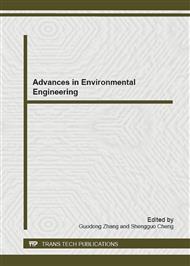p.566
p.570
p.574
p.578
p.582
p.586
p.592
p.598
p.602
Influence of Cathodal Performance on Electricity Generation of Microbial Fuel Cell with Refinery Oil Wastewater as Fuel
Abstract:
A double-chambered microbial fuel cell (MFC) was constructed to investigate the feasibility of electricity generation using microbial fuel cell with refinery oil wastewater as its fuel and the influence of cathodal performance. Results indicated that refinery oil wastewater could be used as fuel in MFCs to generate electricity; catholyte type could influence the electricity generation of MFCs directly and Fe (Ⅲ)-EDTA was the best choice, voltage generation and stable operational period of which were highest and longest; voltage generation increased following with catholyte concentration linear but had little relation to cathode areas.
Info:
Periodical:
Pages:
582-585
Citation:
Online since:
November 2012
Authors:
Price:
Сopyright:
© 2012 Trans Tech Publications Ltd. All Rights Reserved
Share:
Citation:


